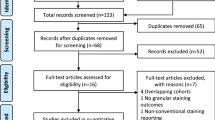Abstract
Trimethylation of histone H3 at lysine 27 (H3K27me3) acts as a transcriptional repressor of target genes. Recent immunohistochemical studies have reported a loss of H3K27me3 modification in diffuse (especially 1p/19q-codeleted) gliomas. However, we did not observe H3K27me3 loss in diffuse gliomas using routine immunostaining conditions for the detection of H3K27me3 loss in malignant peripheral nerve sheath tumors (MPNSTs). Therefore, we conducted immunohistochemical analysis of surgically resected specimens to understand the differences in the H3K27me3 status in MPNSTs and diffuse gliomas and evaluate the diagnostic utility of H3K27me3 immunohistochemistry. Staining with a standard 1:200 dilution of the C36B11 antibody showed a complete loss of H3K27me3 in 5 out of 11 MPNSTs, whereas most diffuse gliomas (149/151, 98.7%) showed diffuse immunoreactivity. At a 1:2000 antibody dilution, 12.6% (19/151) of the diffuse gliomas showed H3K27me3 loss, which was significantly associated with 1p/19q codeletion (P < 0.001). H3K27me3 loss predicted 1p/19q codeletion in IDH-mutant gliomas with lower sensitivity (56.2%) and higher specificity (100%) than ATRX retention or p53 negative result. In conclusion, reduction in H3K27me3 levels was associated with 1p/19q codeletion in diffuse gliomas; however, the extent of reduction differed from that in MPNSTs, and the results depended on the immunostaining conditions.



Similar content being viewed by others
References
Baylin SB, Jones PA (2016) Epigenetic determinants of cancer. Cold Spring Harb Perspect Biol 8:a019505
Esteller M (2007) Cancer epigenomics: DNA methylomes and histone-modification maps. Nat Rev Genet 8:286–298
Shen H, Laird PW (2013) Interplay between the cancer genome and epigenome. Cell 153:38–55
Lee W, Teckie S, Wiesner T et al (2014) PRC2 is recurrently inactivated through EED or SUZ12 loss in malignant peripheral nerve sheath tumors. Nat Genet 46:1227–1232
Zhang M, Wang Y, Jones S et al (2014) Somatic mutations of SUZ12 in malignant peripheral nerve sheath tumors. Nat Genet 46:1170–1172
Prieto-Granada CN, Wiesner T, Messina JL et al (2016) Loss of H3K27me3 expression is a highly sensitive marker for sporadic and radiation-induced MPNST. Am J Surg Pathol 40:479–489
Schaefer IM, Fletcher CD, Hornick JL (2016) Loss of H3K27 trimethylation distinguishes malignant peripheral nerve sheath tumors from histologic mimics. Mod Pathol 29:4–13
Bender S, Tang Y, Lindroth AM et al (2013) Reduced H3K27me3 and DNA hypomethylation are major drivers of gene expression in K27M mutant pediatric high-grade gliomas. Cancer Cell 24:660–672
Venneti S, Garimella MT, Sullivan LM et al (2013) Evaluation of histone 3 lysine 27 trimethylation (H3K27me3) and enhancer of Zest 2 (EZH2) in pediatric glial and glioneuronal tumors shows decreased H3K27me3 in H3F3A K27M mutant glioblastomas. Brain Pathol 23:558–564
Bayliss J, Mukherjee P, Lu C et al (2016) Lowered H3K27me3 and DNA hypomethylation define poorly prognostic pediatric posterior fossa ependymomas. Sci Transl Med 8:366ra161
Panwalkar P, Clark J, Ramaswamy V et al (2017) Immunohistochemical analysis of H3K27me3 demonstrates global reduction in group-A childhood posterior fossa ependymoma and is a powerful predictor of outcome. Acta Neuropathol 134:705–714
Hasselblatt M, Johann PD, Kool M, Fruhwald MC (2017) Reduced histone H3 K27 trimethylation is encountered in about 50% of atypical teratoid/rhabdoid tumors (AT/RT) but is not associated with molecular subgroup status and outcome. Acta Neuropathol 134:817–818
Kakkar A, Biswas A, Goyal N et al (2016) The Expression of Cyclin D1, VEGF, EZH2, and H3K27me3 in atypical teratoid/rhabdoid tumors of the CNS: a possible role in targeted therapy. Appl Immunohistochem Mol Morphol 24:729–737
Katz LM, Hielscher T, Liechty B et al (2018) Loss of histone H3K27me3 identifies a subset of meningiomas with increased risk of recurrence. Acta Neuropathol 135:955–963
Filipski K, Braun Y, Zinke J et al (2019) Lack of H3K27 trimethylation is associated with 1p/19q codeletion in diffuse gliomas. Acta Neuropathol 138:331–334
Pekmezci M, Phillips JJ, Dirilenoglu F et al (2020) Loss of H3K27 trimethylation by immunohistochemistry is frequent in oligodendroglioma, IDH-mutant and 1p/19q-codeleted, but is neither a sensitive nor a specific marker. Acta Neuropathol 139:597–600
Aihara K, Mukasa A, Nagae G et al (2017) Genetic and epigenetic stability of oligodendrogliomas at recurrence. Acta Neuropathol Commun 5:18
Arita H, Yamasaki K, Matsushita Y et al (2016) A combination of TERT promoter mutation and MGMT methylation status predicts clinically relevant subgroups of newly diagnosed glioblastomas. Acta Neuropathol Commun 4:79
Louis DN, Ohgaki H, Wiestler OD, Cavenee WK (eds) (2016) WHO Classification of Tumours of the Central Nervous System. International Agency for Research on Cancer
Takami H, Yoshida A, Fukushima S et al (2015) Revisiting TP53 mutations and immunohistochemistry—a comparative study in 157 diffuse gliomas. Brain Pathol 25:256–265
Ikemura M, Shibahara J, Mukasa A et al (2016) Utility of ATRX immunohistochemistry in diagnosis of adult diffuse gliomas. Histopathology 69:260–267
Feller C, Felix M, Weiss T et al (2020) Histone epiproteomic profiling distinguishes oligodendroglioma, IDH-mutant and 1p/19q co-deleted from IDH-mutant astrocytoma and reveals less tri-methylation of H3K27 in oligodendrogliomas. Acta Neuropathol 139:211–213
Jain SU, Do TJ, Lund PJ et al (2019) PFA ependymoma-associated protein EZHIP inhibits PRC2 activity through a H3 K27M-like mechanism. Nat Commun 10:2146
Lu C, Ward PS, Kapoor GS et al (2012) IDH mutation impairs histone demethylation and results in a block to cell differentiation. Nature 483:474–478
Acknowledgements
We thank Editage (www.editage.com) for English language editing.
Author information
Authors and Affiliations
Corresponding author
Ethics declarations
Conflict of interest
The authors declare no conflicts of interest.
Additional information
Publisher's Note
Springer Nature remains neutral with regard to jurisdictional claims in published maps and institutional affiliations.
Electronic supplementary material
Below is the link to the electronic supplementary material.
Rights and permissions
About this article
Cite this article
Kitahama, K., Iijima, S., Sumiishi, A. et al. Reduced H3K27me3 levels in diffuse gliomas: association with 1p/19q codeletion and difference from H3K27me3 loss in malignant peripheral nerve sheath tumors. Brain Tumor Pathol 38, 23–29 (2021). https://doi.org/10.1007/s10014-020-00382-y
Received:
Accepted:
Published:
Issue Date:
DOI: https://doi.org/10.1007/s10014-020-00382-y




